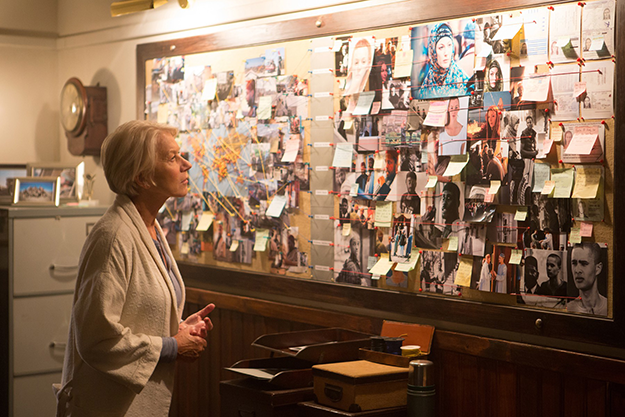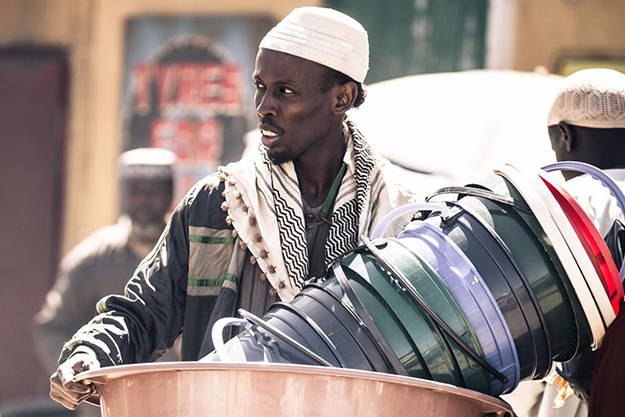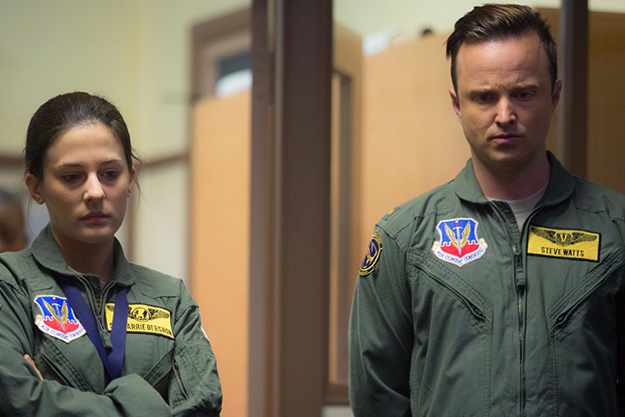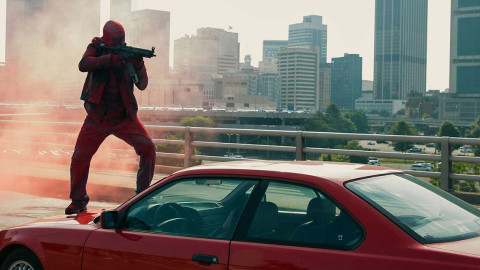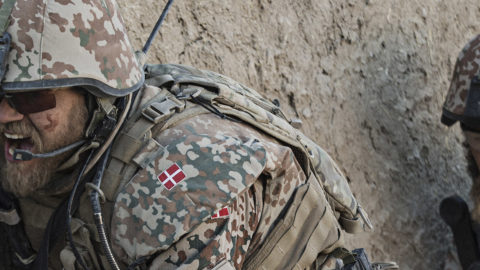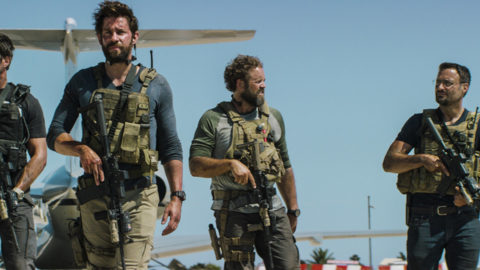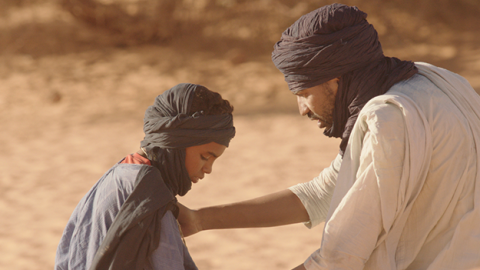Deep Focus: Eye in the Sky
Eye in the Sky starts with the epigraph “In war, truth is the first casualty.” A more pertinent homily would be “The best-laid plans of mice and men often go awry.” This incisive look at a joint United Kingdom/United States drone mission in Kenya, the most artful work yet from director Gavin Hood (Tsotsi, Rendition, X-Men Origins: Wolverine, Ender’s Game), dramatizes the sophistication and limits of high-tech warfare. Not even cutting-edge global communications and Unmanned Aerial Vehicle technology assures British Colonel Katherine Powell (Helen Mirren) that Kenyan troops 4,200 miles away will wrest a clutch of al-Shabaab terrorists from a safe house in Nairobi. Her main target is a U.K. citizen turned terrorist, Susan Danford, whom Powell has been tracking for six years.
As Powell’s commander, Lt. General Frank Benson (Alan Rickman), observes the operation with civilian officials in Whitehall at COBRA (Cabinet Office Briefing Room A), Powell coordinates her plans with a drone pilot in Nevada (Aaron Paul) and image-ID specialists in Hawaii as well as Kenyan forces close to the target. Powell expects Kenyan commandoes to storm the house and capture Danford and others in the top ten of the British government’s Most Wanted list, plus two new recruits (including an American). But before Powell can certify that a veiled woman in their sights is Danford, these armed radicals motor from an upscale home in Nairobi to a slum area controlled by Islamist extremists. It’s impossible to send in Kenyan ground forces: the move would ignite bloody anarchy. Powell’s only hope is getting the authorization to move her mission from “capture” to “kill”—and turn her Las Vegas-based drone pilot from “eye in the sky” to executioner. As the British work their way through links of the “Kill Chain”—the chain of command required to authorize an armed attack—the suspense becomes excruciating.
Guy Hibbert, best known to American audiences for Prime Suspect 4 (or Prime Suspect: The Scent of Darkness), has written a dexterously plotted screenplay that’s piquantly detailed and streaked with personal observation. In the wrong hands, this high-tech concept might have registered as a trick movie, like watching a jigsaw puzzle come together by itself. Yet Hibbert works an element of uncertainty into each jagged scene, and he inserts scraps of character that the actors expand on without overplaying their hands. Hood cannily exploits the rift between military professionalism and “the human factor” that’s a central part of Hibbert’s cinematic blueprint. Eye in the Sky is set in the halls of major powers and is mechanically more sophisticated than Tobias Lindholm’s brilliant A War (about Danish soldiers in Afghanistan), but it breathes the same compromised air. Writer-director Lindholm questions whether the civilized waging of modern combat is an oxymoron. Hood and Hibbert mingle heartbreak, absurdity, and desperation as they depict politicians and diplomats striving to apply legal standards and contain collateral damage as Powell and Benson push for a targeted assassination.
The movie begins within the walled yard of a bicycle repairman whose wife bakes bread in an open-air oven while their daughter gyrates in a Hula hoop. From the moment the camera swings skyward to a drone’s-eye-view of this happy home and its scrappy neighborhood, you know the 9-year-old girl, Alia (Aisha Takow), will figure in the action. Sure enough, she sets up a table to sell her mother’s bread just outside the home where the terrorists put together suicide vests and record martyr videos. Kenyan surveillance specialist Jama Farah (Barkhad Abdi, the great Somali-born actor from Captain Phillips) has enabled Powell to spy on this suicide-bomber base camp with a “Micro Aerial Vehicle” (MAV) in the shape of a beetle. (Earlier, we’ve seen another remarkable MAV: a robot hummingbird.) He must now improvise plans to remove Alia from the path of a Hellfire missile. If he doesn’t succeed, adults a world away will decide whether it’s worth risking a little girl’s life to prevent a suicide bombing that could kill 80 people.
The movie’s narrative is like a ticking-bomb plot squared: Will the suicide bombers exit before the Brits and Americans take action? Will Powell call in the strike before Farah pulls Alia out of the way? Eye in the Sky’s constant intrigue is rooted in nonstop shifts of perspectives from Kenyans in immediate danger to the people who decide their fate—decision-makers in England, a drone team outside Las Vegas, the image-I.D. masters at Pearl Harbor, and foreign-policy experts who weigh in from Singapore, Beijing, and Washington, D.C.
This movie doesn’t feel as glib or as heartlessly manipulative as that rough outline sounds. Perhaps that’s because it’s so upfront about its manipulations. The movie signals right from the beginning that every micro-bit of action will count, so you’re gratified, rather than irritated, when each moment adds to the film’s palpable moral tensions and escalating, visceral suspense. Hood is an ace at suggesting hidden stress in mundane situations, like the everyday bustle at an airport. He knows how to photograph a Kenyan spy, who records the arrival of two terrorists, so we notice him and they don’t. He also pulls off a life-or-death footrace through a labyrinthine urban district. This sprint is comparable in impact to a setpiece in a Bourne film, partly because Hood doesn’t shoot it like a Bourne film. Most contemporary action directors destroy geography. Hood guides us through every intersection with terrific clarity. Throughout, his work with cinematographer Haris Zambarloukos (Venus, Thor, Jack Ryan, Cinderella) is sharpshooter-steady, not jittery. And they’re as canny at capturing quirks of character in intimate portraits as they are deft at creating panoramas of municipal blight. As one legal functionary or cabinet member after another “refers up” to an off-site higher official rather than dare make a decision, you see the panic and confusion in their eyes. Even the most steadfast opponent of the aerial attack, the undersecretary of state for African affairs (Monica Dolan), resorts to selfish argument: it’s better publicity for the British that al-Shabaab kill 80 people than for them to kill one knowingly. Hovering over it all, with a fine disdain, is Rickman. In his final on-screen role, he never makes the activist actor’s classic mistake of editorializing against the military while playing a soldier. His air of disbelief at civilian indecision lends the proceedings a tinge of black comedy. It’s entirely earned: we believe Benson when he says that he’s witnessed, firsthand, the aftermath of five suicide bombings. (Not even Rickman, though, can pull off the script’s most dubious touch: the general’s attempt to purchase the right doll for his granddaughter, which begins as comic relief and ends as a failed stroke of bitter irony.)
In her half a dozen years of desperately seeking Susan Danford, Powell has assembled a collage of Danford and her associates as elaborately intertwined as Carrie Mathison’s walls of shame in Homeland. At the movie’s peak of lucidity, those multicolored strings spanning time zones and continents thread through your brain. Rebounding from her tinny Hedda Hopper in Trumbo, Mirren is once again nonpareil. She conveys psychic tumblers falling into place as Powell sees Danford slip into and out of her grasp. For Powell, the image of these terrorists assembling suicide vests is appalling and an adrenaline boost. She realizes that their actions should speed up the official acceptance of the missile strike. Mirren isn’t afraid to put her subtlety and charisma at the service of a flawed commander. The pressure Powell puts on the sergeant responsible for predicting collateral damage is both horrifying and persuasive (and beautifully prepared for in the script).
Hood’s shrewd deployment of heavy filmmaking machinery enables us to share some of Powell’s urgency. When a movie or a military mission commands so many talented individuals and so much intricate materiel, their plans develop a momentum of their own that can supersede specific goals. Eye in the Sky isn’t a particularly probing work. It’s basically a procedural. But the breadth of Hood and Hibbert’s focus gives the film more intellectual heft than previous explorations of drone warfare. Andrew Niccol’s film Good Kill, starring Ethan Hawke, and Julie Taymor’s stage production of George Brant’s Grounded, starring Anne Hathaway, focused on the alienating effects of drone warfare on fliers who are used to sitting in the cockpit of real planes.
In Hood’s Eye in the Sky, Aaron Paul’s conscience-stricken pilot is affecting, and you cheer him on when he challenges an order that he considers inhumane and precipitate. But he’s neither the hero nor the antihero of this piece. He’s the final ring in the Kill Chain.
Michael Sragow is a contributing editor to FILM COMMENT and writes its Deep Focus column. He is a member of the National Society of Film Critics and the Los Angeles Film Critics Association. He also curates “The Moviegoer” at the Library of America website.



